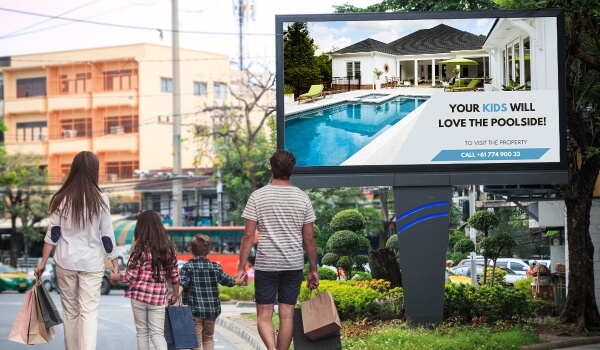
Dec 22 2022
5 min read


Dec
When it comes to advertising, brands should realize how the choice of advertising medium impacts their business.The world is rapidly approaching digital reality, metaverse, and whatnot. Digital means offer certain perks that conventional mediums find impossible to match. It all starts and ends with flexibility.
Digital signage offers advertisers a world of opportunities to experiment with creative storytelling and human-computer interactions. In addition to the creative freedom, the software powering digital screens enables the advertising networks to scale and generate massive traction without crossing the hellfire of printing, processing, and regulating cross-channel consistencies.
With digital signage, launching advertising campaigns can be automated, for the most part.
Advertising screens take various shapes, sizes & forms, from the familiar billboard screens to the fast-growing interactive ads! But what does each of these digital signage ad mediums mean for a business? Let’s take a look!
DOOH displays content images, posters, social media feeds, and dynamic content like animations or commercials. DOOH is quite the rage in shopping malls, airports, and bus stops. Brands that use these ads often target a larger pool of audiences. For example, clothing brands, QSR chains, or hotel-booking services.
Here is an example:

Indoor Narrowcasting refers to using digital signage within your store, cafe, or restaurant to grab the attention of incoming visitors. In contrast to DOOH (Digital Out-of-Home) displays, these digital setups are tailored to specific audience types. This might include featuring new releases prominently on central screens or installing digital signs in store windows to showcase exciting offers.
Narrowcasting involves a digital signage network such as interactive digital signage displays Showing ‘spin the roulette to win what’s on screen.’ That hugely contributes to increasing the brand recall rate - something quite unachievable with a vinyl ad poster.

In layman’s terms, this digital signage advertising involves tailor-fitting ads to your audience through software programming. In such forms of advertising, intelligent digital signage systems automatically show the most relevant content based on the audience persona in the vicinity.
In addition to recognizing the audience’s characteristics, programmatic advertisements can now adapt their content according to the surrounding atmosphere. For instance, imagine seeing a tempting display of fresh mint chocolate ice cream on a digital billboard at the subway station when the temperature crosses 25 degrees Celsius. Similarly, picture a digital sidewalk sign swiftly transforming into a real estate advertisement as it detects a family of three walking by.
nteractive ads initiate consumers to engage with the ad in an immersive way, turning an otherwise on-way ad monologue. They are an excellent way for marketers to reach out to consumers directly, encouraging them to act along rather than view an ad or ignore it altogether.
Studies have found that interactive advertising is retained longer than a typical ad, and at least 30% of the viewers tend to recollect what they have seen when engaging with it in some form or the other.
Digital signage is the only medium for blending interactivity with offline advertising. Take a look at this mindblowing interactive ad campaign for Fanta by JC Decaux:
Building a digital signage advertising network requires hardware, software, and a content management system that will make screen management as smooth as possible. For example, the greatest challenge in building an advertising network is remote and real time cms solution enabling frequent refershes in the adverts on screen.
An ad signage network comprises several screens that businesses use to make their audience aware of what they are up to― launches, discounts, vouchers, free trials, etc. As companies increase the number of digital advertising screens in their facilities, they shift towards becoming a fully-functioning digital signage network.
If your ad company has electronic displays and you wish to establish an advertising network, a great place to work is a supply-side platform (SSP) that connects your network to an open exchange. To ensure the advertisers are a good fit for your screens, you can set parameters around the ad content you would like to publish on your screens and also put certain ad content “off limits” if it is inappropriate for you.
Typically, the screen dimensions vary between 6 feet to 14 feet in length and 12 feet to 48 feet in width, depending on what you intend to display.
The signage media players should ideally be system compatible and consume less power while offering optimal performance.
Finally, the content you put up on screens is what sets the ball rolling for the network, and here comes the images, animations, videos, or GIFs you would like to see on your screens!
Book My personalized demoThis section can be divided into three segments - signage market overview, factors driving the business models, and types of deployments.
A recent study by Fortune Business Insights pointed out that the digital signage market is projected to reach a market size of $35.94 billion by 2026. The network that often goes beyond the basics of the traditional hardware-software-content trio is a gateway to business opportunities for value-added resellers (popularly, VAR).
The following factors influence how digital signage advertising networks work.
Integrations offered by the software.
Value chain linking screen suppliers to the tech manufacturers.
Signage deployment measures that identify and match the renters of ad spaces to the renter form the very basis of the business model.
Digital signage content creation is crucial to a successful digital signage strategy. By creating compelling and engaging content and utilizing effective content management techniques, businesses can engage more effectively with their potential customers and achieve their marketing objectives and advertising goals.
Three types of digital signage deployments constitute the signage advertising business model: merchandising, promotional, and informational.
This form of digital signage advertising is usually found in retail stores, banks, or restaurants and is meant to increase sales through brand awareness. These do not generally consist of the brand offers, such as discounts or vouchers, but an image, video, or animation showing what the brand is about and offers—for example, a subway ad by H&M showcasing dresses and cardigans at the store beside the crosswalk.
Commonly seen in transportation venues such as airports, theaters, digital footpaths, and other high-traffic public spaces, the promotional form of digital signage advertisement aims to create a buzz about the launches and discounts or vouchers a brand offers. For example, an airport-lounge ad for Mango highlighting the brand’s highest-ever 20% off pre-winter sale.
Popular hotels, healthcare facilities, educational campuses, churches, and museums use digital signage ads to educate or inform the target group. These advertisements frequently blend promotion and entertainment with information. A good example would be the church’s digital signage displaying All Souls’ Day or Christmas mass timings or instructions on donating to a cause.
Now that we are acquainted with what a digital signage ad campaign can mean to a business, let’s look at some successful ad signage campaigns that not just helped enhance customer experience but brought out a new side of brands loved by millions!
With 200+ stores across some of the major cities in the Indian subcontinent, Decathlon faced the challenge of reaching out to the maximum audience across all stores and promoting new launches in one go. That’s when the famous sporting brand decided to take the digital plunge!
It deployed 55-inch thin panels, video walls, and Android tablets at various points of purchase, such as the in-store decompression zones, product aisles and shelves, and on the merchandise body. To manage the ad content distribution across its pan-nation screen network, Decathlon used Pickcel’s digital signage solutioning platform.
Read the full story of Decathlon's success journey here.
Raffles city, home to some of Singapore’s (the world’s) most prominent names in the fashion and beauty industry, saw a tech twist with Sephora cosmetics going all digital with their products! Empowered with Zoom Visual’s software, the brand leveraged customer experience by electronically displaying what they have on offer, highlighting special deals and discounts, providing “How to” guides, promoting new launches, and much more!
The store uses a combination of digital displays such as hanging LED panels, visually appealing digital posters, and a P1.58mm LED Display Screen that works like a high-resolution dynamic canvas.
Interact with customers more effectively and showcase your entire product range at one go across all stores
Boost impulse purchases by dynamically showing attractive offers on Point-of-Purchase displays during the peak-footfall hours
Remote management of what shows up on the screen alongside the flexibility of real time updates
Play synchronized ads across all stores on a state, national or global scale.
Avoid additional costs of replacing and repairing billboards, significantly slowing advertising agencies’ business.
Get valuable insights on consumer behavior and brand-customer interactions through screen analytics.
Digital signage ad screens are one of the most common ways to communicate your brand message! But where do they tend to get noticed the most? Here is a list of places where your advert will likely get noticed!
Read: Tips to make the most of your outdoor signage
Read: How NEC India uses screens to make bus commute easier
Read: Beyond the conventional use of elevator signs
Read: Best ways to use gas station digital signage for advertising
Read: Use cases of digital signage in shopping malls
A digital signage ad network of your own comes with its costs and benefits.
Pros:
Complete control over what you choose to display on the screen without needing agency approval.
Repurpose the corporate digital signage software for corporate communications, employee recognition, and internal branding.
Freedom to experiment with content by frequently changing and testing various ads & promotions.
Cons:
The initial setup cost of owning a screen network might be heavy for small businesses.
With most display software now available in the cloud, there is a bare minimum need for any IT infrastructure. Nevertheless, the upkeeps of hardware components will require additional effort.
If you look around, digital signage is slowly becoming an integral part of marketing & advertising. At least 3 in 5 of us would consider scanning a QR to book a table at a restaurant than enquire at the restaurant counter. And with advertisers looking to go for more than old wine in a new bottle, it’s time for your business to hop on the bus before it’s too late.
Take complete control of what you show on your digital signage & how you show it.
Take complete control of what you show on your digital signage & how you show it.
Start Free Trial Schedule My Demo
Dec 22 2022
5 min read

Nov 30 2022
9 min read

Nov 23 2022
6 min read

Nov 11 2022
8 min read